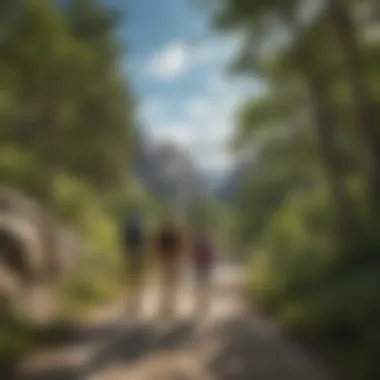Explore Campgrounds Near Mount Rushmore


Intro
Mount Rushmore, a monumental emblem of American history carved into the granite face of the Black Hills, is surrounded by a wealth of natural beauty and outdoor adventure opportunities. Nestled within a diverse landscape, the campgrounds that dot the vicinity present travelers with options ranging from rustic experiences to those that offer a touch of comfort. Understanding the camping scene near Mount Rushmore means diving deeper than just finding a spot to pitch a tent or park a camper. It's about engaging with the wilderness, respecting the ecological systems that thrive in the shadows of the iconic faces, and enjoying the unique attributes each campground offers.
In this guide, we will explore the various campgrounds around Mount Rushmore, discussing their amenities, accessibility, and the enchanting features of the surrounding area. We will also touch on responsible camping practices that enhance the experience for everyone visiting this iconic South Dakota landmark.
Understanding Woodland Ecosystems
In the region surrounding Mount Rushmore, the woodland ecosystems play a pivotal role in not only the landscape but also the experience one can have while camping.
Importance of Biodiversity in Forests
Biodiversity is the backbone of healthy forest ecosystems. The rich variety of flora and fauna in the Black Hills contributes to their stability and resilience against climate change, pests, and diseases. Camping in this ecosystem means immersing oneself in environments teeming with life, from towering ponderosa pines to the myriad of wildlife that roam under their canopies.
Some insights into biodiversity include:
- The presence of rare species such as the black-footed ferret and the pallid sturgeon.
- Diverse plant life that offers food and habitat for various animal species.
- Overall ecosystem services, such as water filtration and carbon sequestration, that help our planet.
"In healthy ecosystems, every species plays a role, much like each piece in a well-crafted puzzle."
Role of Forests in Climate Regulation
Forests surrounding Mount Rushmore also assume a critical role in climate regulation. They act as carbon sinks, absorbing CO2 from the atmosphere and releasing oxygen, which is essential for sustaining life. Furthermore, forests help maintain local climates, moderating temperatures and maintaining humidity levels.
An interesting aspect of these woods is how they interact with the geography of the region. The elevation and terrain create microclimates, allowing for unique biological communities to flourish. Understanding this relationship deepens a camper's appreciation for the space surrounding Mount Rushmore.
In sum, the campgrounds near Mount Rushmore invite you to witness first-hand the delicate balance of nature at play. Recognizing the significance of these ecosystems enriches the overall experience of camping in the Black Hills.
Intro to Mount Rushmore Campgrounds
When pondering a trip to Mount Rushmore, one might imagine the awe-inspiring granite faces of past leaders, forever etched into the scenery of the Black Hills. However, the experience doesn't end there. The campgrounds surrounding this iconic monument offer an essential connection to the natural world that amplifies a visit beyond mere sightseeing. Camping here is not just an itinerary item but an enriching opportunity to embrace the tranquility and splendor of the surrounding landscapes, wrapping oneself in the embrace of the great outdoors.
Over the years, Mount Rushmore's campgrounds have catered to diverse groups — from adventurous families seeking to spend quality time together, to solo travelers yearning for solitude amid majestic pines. The blend of historical significance, recreational opportunities, and the necessity for sustainable practices makes camping around the monument a nuanced subject worth delving into. Recognizing the pivotal role that these campgrounds play can greatly enhance one's trip.
Historical Significance of Mount Rushmore
Mount Rushmore is much more than just a monument; it is a testament to American ideals and a celebration of democracy. Constructed during the Great Depression, the faces of George Washington, Thomas Jefferson, Theodore Roosevelt, and Abraham Lincoln symbolize the nation's rich history and its evolution. For visitors, camping nearby allows for a deeper understanding of this historical context. By resting under the stars, one can reflect on the significance of these leaders and the respective eras they represent.
It’s worth noting that the site itself is steeped in Native American history, particularly among the Lakota Sioux tribe. Understanding this Aboriginal backdrop enhances the camping experience.
The Importance of Camping in Natural Settings
Camping is inherently linked to nature. Engaging with the outdoors brings a multitude of benefits, from reducing stress to fostering personal connections. Studies show that spending time outside can significantly boost mental acuity and improve mood, making it a vital activity in today’s fast-paced world.
In the vicinity of Mount Rushmore, the campgrounds provide a prime opportunity for immersion in nature’s splendor.
- Fresh air and beautiful views? Check.
- Wild wonders waiting to be discovered? Absolutely!
- Adventure and relaxation packaged together? Without a doubt.
Camping prompts individuals and families to unplug and connect with each other and the environment. In a digital age where screens often dominate interactions, spending a few nights enveloped by the towering pine trees helps recenter oneself and fosters strong bonds. Plus, there's nothing like gathering around a campfire, sharing stories while being serenaded by the gentle whisper of the wind and the distant calls of wildlife.
"Nature does not hurry, yet everything is accomplished." – Lao Tzu
Choosing to camp surrounding Mount Rushmore is, therefore, a significant decision. It is not merely about resting your head at night but rather choosing to embrace the beauty and lessons offered by this rich landscape.
Types of Campgrounds Around Mount Rushmore


When planning a camping trip around Mount Rushmore, understanding the types of campgrounds available can greatly influence the overall experience. Each campground offers distinct attributes, catering to a variety of campers, from families seeking comfort to adventurers looking for rugged landscapes. Knowing these differences helps in making informed choices, ensuring a memorable stay amidst nature's bounty.
National Parks and Forests
The natural beauty surrounding Mount Rushmore is enhanced by its proximity to national parks and forests. These protected areas not only provide camping opportunities but also foster a deeper connection with the environment.
Black Hills National Forest
Black Hills National Forest stands out as a premier destination for campers. This forest is a sprawling expanse of hardwoods and conifers that creates a stunning backdrop of green against the granite spires. The key characteristic of this area is the sheer variety of recreational activities it accommodates. From camping, hiking to mountain biking, there's something for everyone.
One unique feature of Black Hills National Forest is its extensive network of trails. With over 1,300 miles of trails, visitors can embark on anything from leisurely strolls to arduous treks with panoramic views.
While the vastness of the forest is definitely a plus, it can also be daunting. Those not accustomed to remote camping might find certain sites more isolated than intended. Despite this, the forest's ability to immerse visitors in nature is unparalleled, making it a beneficial choice for both amateur and seasoned campers.
Badlands National Park
Badlands National Park, with its dramatic landscapes, offers an experience unlike any other. The sharply eroded buttes, pinnacles, and deep canyons create a unique and somewhat surreal atmosphere. The park’s key characteristic is its array of geological formations that tell tales of ancient oceans and ecosystems.
What sets Badlands apart is its impressive wildlife and flora. Home to bison, prairie dogs, and various bird species, one can expect some truly memorable moments amidst the beautiful scenery. The ability to witness wildlife in their natural habitat while camping is a significant draw for nature enthusiasts.
However, the rugged terrain can pose challenges for those unaccustomed to more traditional campgrounds. Facilities may be limited, thus visitors should come prepared for a more back-to-basics experience. Still, those who venture to Badlands are often rewarded with breathtaking sunsets and remarkable night skies, solidifying its charm.
Private Campgrounds and RV Parks
In sharp contrast to the natural landscapes of national parks, private campgrounds and RV parks provide campers with more amenities and comforts. These facilities often cater to families and individuals looking for a more organized camping experience.
Family-owned Campgrounds
Family-owned campgrounds exude a homely atmosphere that cannot be replicated by larger commercial ventures. These sites often stem from a passion for the great outdoors and provide personalized service that emphasizes local culture and hospitality. Visitors may appreciate the stories shared by the owners, which can enrich the camping experience.
What makes family-owned campgrounds appealing is their balance of comfort and intimacy. Many of these spots offer unique amenities such as campfire pits, picnic areas, and playgrounds for children. However, it’s vital to recognize that availability may be limited, especially during peak seasons, necessitating early planning.
Commercial RV Parks
On the other side of the spectrum, commercial RV parks cater primarily to those traveling in recreational vehicles. These parks provide a myriad of conveniences including full-hookup sites, which can make camping significantly easier for families and travelers.
The essential appeal of commercial RV parks lies in their accessible location and comprehensive facilities. Many parks are equipped with laundry rooms, general stores, and sometimes even swimming pools, turning camping into a more comfortable retreat.
However, these conveniences come with a trade-off; the ambiance may feel more artificial, lacking the serene nature experience some seek. As a result, campers may need to balance convenience with the authenticity of their outdoor experience.
In summary, whether it’s the rugged allure of national parks or the comforting embrace of family-run campgrounds, the types of campgrounds available around Mount Rushmore are diverse. By thoughtfully assessing each option, one can ensure a camping experience that aligns with personal preferences and desired levels of comfort.
Selecting the Right Campground
Choosing the right campground is more than just picking a spot to pitch a tent. It’s about finding a space that resonates with your needs, preferences, and the adventures that await in the vicinity of Mount Rushmore. The right campground can enhance your experience, providing not only comfort but also opportunities for exploration and connection with nature. It's of utmost importance to consider what facilities and location will suit your camping style. A well-suited campground facilitates accessibility and adventure, allows you to recharge, and helps foster memorable experiences.
Assessing Amenities and Facilities
When on the hunt for a campground, amenities and facilities make a world of difference. It can turn an average outing into a top-notch experience. Let's dig into some specifics.
Restroom Facilities
One of the non-negotiables for many campers is access to restroom facilities. Clean and well-maintained restrooms can greatly affect comfort levels when camping. The key characteristic of these facilities is hygiene. Campgrounds that prioritize cleanliness tend to attract a better crowd, ensuring a more pleasant stay. A campground like the KOA near Mount Rushmore, for instance, features regularly cleaned restrooms with privacy stalls, which is a big plus for families and larger groups.
However, some remote campgrounds might have only basic outhouses, which can be less than ideal. Thus, assessing restroom facilities can play an integral role in determining the overall camping experience.


Water Supply
Water is another vital aspect to consider. Access to fresh water can determine both comfort and safety during your trip. Campgrounds that offer potable water supply not only allow for easy hydration but also facilitate cooking and general cleanliness. The Black Hills National Forest campgrounds typically come equipped with water spouts throughout the grounds, making it easy for campers to fill up their bottles whenever needed.
However, some campgrounds may have limitations on water supply based on seasons or usage. It’s best to observe these characteristics ahead of time to avoid any unwelcome surprises while camping.
Electric Hookups
For those who enjoy the comforts of home, electric hookups become a factor of significance. They allow for the use of appliances to make life easier while camping, like charging mobile devices or running a portable refrigerator. Campgrounds like Prairie Berry Winery's holiday facility feature ample electric hook-up spots tailored for RVs, making it a popular choice among travelers seeking a blend of rustic and tech-friendly amenities.
On the downside, not all campgrounds offer these facilities. If you're a tent camper, you might not feel the need for electric access, but it's worth considering if you're relying on electronic gear.
Evaluating Location and Access
The location of your campground can enhance your entire trip. Simply put, the right spot opens up avenues for adventure, exploration, and picturesque views.
Proximity to Mount Rushmore
How close you are to Mount Rushmore can dictate how flexible your itinerary is during your stay. Being near the monument allows for spontaneous trips to see the majestic faces, perfect for sunrise or sunset views. Campgrounds situated within a short drive, such as Custer State Park, provide easy access and the chance to witness the lighting changes on the monument throughout the day.
It's worth noting, however, that proximity can come with drawbacks like larger crowds. Busy areas risk losing the tranquility that many campers crave.
Scenic Views and Trails
A campground nestled in a scenic area can transform your camping experience. Picture rolling hills, expansive skies, and serene landscapes at your doorstep. For example, campgrounds at the foothills of the Black Hills offer breathtaking views and immediate access to trails that are perfect for hiking or leisurely strolls.
Yet, while scenic views are a draw, not all campgrounds deliver immediate access to trails. Some may require a short hike or a drive, which is a consideration for campers wishing to maximize their outdoor activities without extensive travel.
"Selecting the right campground is not just about convenience, it's about crafting an experience that resonates with your spirit of adventure. Don’t just camp—immerse yourself in nature's beauty."
By weighing these factors like amenities, facilities, location, and access, you can find a campground that enhances your visit to Mount Rushmore, aligning with your expectations and needs.
Camping Experiences and Activities
When it comes to camping near Mount Rushmore, the experiences and activities available to visitors contribute significantly to the overall enjoyment and connection with nature. Engaging in outdoor activities not only enhances the camping experience but also fosters a deep appreciation for the local environment. Whether you are a seasoned hiker or a wildlife enthusiast, the surrounding areas offer ample opportunities to explore and immerse oneself in the beauty of the Black Hills.
Hiking and Nature Trails
Popular Hiking Trails
Hiking around Mount Rushmore taps into one’s inner explorer, showcasing trails that cater to various skill levels. One prime example is the Harney Peak Trail, which is a challenging hike rewarding adventurers with a panoramic view from the highest point in South Dakota. The unique aspect of this trail is its rich history—once considered a sacred place by the Lakota Sioux, it appeals not just to hikers but also to those seeking cultural insights.
Hiking provides multiple benefits: it promotes physical health, mental well-being, and a more profound connection with nature. However, it’s essential to be mindful of your fitness level and trail conditions.
Guided Nature Walks
On the flip side, guided nature walks present a fantastic way to learn about the local flora and fauna, led by knowledgeable guides who share a wealth of information. These walks often occur at dawn or dusk, providing a unique atmosphere and enhancing the chances of spotting wildlife when they are most active. The key characteristic of these guided sessions is that they are informative while immersing participants in the landscape.
Such walks give a significant advantage for those unfamiliar with the area. They offer insights into various species, ecological history, and conservation efforts. However, sometimes participants may feel constrained by the pace set by the guide.
Wildlife Observation Opportunities
Bird Watching
Bird watching expands the camping experience into an engaging hunt for feathered creatures. The Black Hills are home to over 200 species, such as the American goldfinch and the bald eagle. This aspect of camping becomes a delightful challenge that draws nature lovers into the beauty and intricacies of local ecosystems.


The benefit of bird watching is its accessibility; it can be enjoyed from the comfort of a campsite or while venturing into the wild. But, for those who want to maximize their experience, equipping oneself with good binoculars and a bird field guide proves invaluable.
Wildlife Photography
For those with a passion for capturing intricate details of wildlife, wildlife photography offers an exciting avenue. The Black Hills’ unique ecosystem creates exceptional opportunities to photograph diverse species in their natural settings. Moreover, getting the perfect shot often becomes a rewarding challenge, pushing photographers to observe behaviors and nuances in wildlife that might go unnoticed by the casual observer.
Using photography as a medium to reflect on camping experiences engages both the camper and the natural world. However, it does come with its own set of challenges. One may need to practice patience, as wildlife does not always follow the script. Yet, the payoff can be incredible, creating lasting memories.
Ultimately, the multifaceted experiences available to campers around Mount Rushmore highlight why the region is such a beloved destination. With a commitment to environmental respect and enjoyment of the outdoors, these activities enrich the camping experience.
"Nature is not a place to visit. It is home."
Embracing these experiences allows for a deeper connection with the land and its history, instilling respect for both the natural wonders and the conservation efforts necessary to protect them.
Environmental Considerations for Campers
Camping, while a pleasurable experience for many, comes with a heavy responsibility toward preserving the environment. This section focuses on two pivotal aspects: adapting to Leave No Trace principles and minimizing our impact on the surrounding nature.
Leave No Trace Principles
The Leave No Trace principles serve as guidelines for environmental stewardship, ensuring that visitors can enjoy the outdoors without detrimental effects on the ecosystem. These principles are not merely suggestions; they are essential practices developed from extensive research and real-world experiences in outdoor recreational activities. The fundamental idea is to help campers understand that their actions can impact the delicate balance of nature.
By practicing these principles, visitors can reduce their ecological footprint in various ways. For instance, the first point emphasizes planning ahead and preparing. This entails knowing the area you're camping in—its wildlife, plant life, and even weather conditions. This forethought not only enhances your experience but also helps mitigate potential disruptions to the natural habitat.
Minimizing Environmental Impact
Proper Waste Disposal
Proper waste disposal is crucial in maintaining the integrity of camping sites. Campers should understand that littering, intentional or otherwise, can jeopardize wildlife and pollute the ground and waterways. Simple things like making sure to use designated trash receptacles or packing out what you pack in can make a world of difference.
The key characteristic of proper waste disposal is its inherent simplicity. Following basic protocols such as using biodegradable soaps when cleaning up and keeping food scraps contained keeps unnecessary temptations away from wildlife while contributing to a cleaner ecosystem. This practice reflects respect for nature and promotes a pleasant experience for all visitors. The unique merit of proper waste disposal lies in its proactive nature, which empowers individuals by turning every camper into a guardian of their surroundings. However, neglecting waste disposal can lead to serious issues, from attracting pests to harming local wildlife.
Sustainable Camping Practices
Sustainable camping practices emphasize the importance of making conscious choices during the camping excursion. This can include selecting eco-friendly gear, staying on established trails, and being mindful of noise pollution. Such practices not only ensure the preservation of landscapes but also maintain the serenity of the experience—a chance for many to connect deeply with nature.
A vital characteristic of sustainable camping is resourcefulness. For instance, using solar chargers or bringing reusable utensils cuts down on waste significantly. Such choices echo the broader conversation surrounding sustainability and ecology in today’s world. However, it’s important to note that while sustainable practices can enhance a camping experience, they do require campers to change long-standing habits, which may pose challenges initially.
"The choices we make while camping affect not just our immediate surroundings but also the broader ecosystem. Every little effort counts!"
These environmental considerations remind us that camping should not merely be viewed as a recreational activity, but rather as a shared responsibility to honor and protect the remarkable landscapes we enjoy. By focusing on Leave No Trace principles and minimizing environmental impact, campers can ensure that future generations of nature enthusiasts will have the pleasure of experiencing the beauty of sites like Mount Rushmore and the Black Hills.
Closure: Embracing Nature Around Mount Rushmore
As the sun sets behind the majestic faces carved into the granite, the significance of camping around Mount Rushmore becomes poignantly clear. Recognizing this area as an intersection of history, natural beauty, and community, campers are encouraged to immerse themselves in the surrounding landscapes. Not only does camping offer a chance to break away from the hustle and bustle of modern life, but it allows individuals and families to reconnect with nature in its most genuine form.
The Lasting Legacy of Camping in the Black Hills
The Black Hills provide a living chronicle of human interaction with nature. Historically, this region is rich with stories that span generations—from the Indigenous peoples who first called this area home to the contemporary campers that flock here today. Camping within this rich tapestry offers a distinctive opportunity to appreciate not just the natural environment, but also the culture and history that shape it.
Families that camp in the Black Hills often pass down traditions to their children, like hiking the same trails their parents once explored. This culture of camping supports not only personal connections but also a communal sense of responsibility towards the land and its preservation. Such memories can last a lifetime, creating bonds and stories shared around the campfire that echo the spirit of the land itself.
Future of Camping and Conservation
Looking ahead, the marriage of camping and conservation will play a pivotal role in preserving the beauty of the Black Hills for generations to come. As more visitors come to explore these stunning landscapes, it’s imperative that responsible camping practices are prioritized. Initiatives like Leave No Trace have gained traction, providing essential guidance on how to minimize impact and maintain the integrity of natural environments.
A key aspect of future camping will likely involve education and collaboration between campers and conservation groups. This could involve:
- Workshops on sustainable practices to promote eco-friendly camping strategies.
- Community involvement in local projects aimed at wildlife protection and habitat restoration.
- Enhanced regulations that limit overcrowding in sensitive areas, ensuring ecosystems are not strained by too much foot traffic.
"Preserve the natural beauty so future generations can also experience its splendor."







